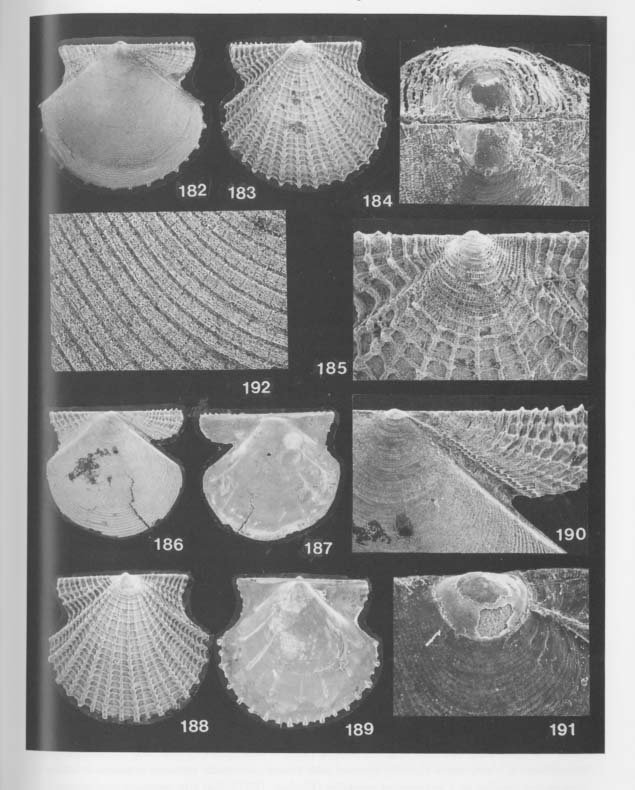Systematic Description
Parvamussium decoratum sp. nov.
|
  |
Material.—Holotype: RM19572a, a living specimen attaching itself to algal balls by byssus, collected from the sublittoral bottom (about 70 m deep) off the southern coast of Ie Islet, Okinawa. Paratypes; RM19452 (dead) from "Devil's Palace", RM19453 (dead) from "Fool's Palace", RM19597 (dead) from "Toriike", RM19454 (dead) from "Black Hole" and RM19598 (partly living) from "Coral Hole" of Shimoji Islet. RM19455 (dead) from "Cross Hole" of Irabu Islet. RM19572 (living) from the type locality.
Diagnosis.—Small-sized, relatively low species of Parvamussium, characterized by nearly equilateral disk, clearly defined large auricles of subequal size, coarsely cancellate ornaments of LV consisting of strong radial ribs of two orders and prominent commarginal lamellae which become denser toward the umbo, and a few rudimentary internal ribs in each valve.
Description.—Shell small for genus, scarcely exceeding 5.0 mm in length, dirty white, opaque, longer than high. Disk nearly equilateral, with slightly concave antero-and postero-dorsal margins. Apical angle about 100°. Byssal notch deep, with comparatively weak radial costae. Posterior auricle relatively large, acutely angulated, subequal to anterior in size; umbo placed near mid-point of dorsal margin. Disk of LV and auricles of both valves possess coarsely lattice ornaments. Radial ribs on disc of LV consist of two orders: primary ribs about 10 in number, very stout, starting about 1 mm from the umbo; secondary ribs alternate almost regularly with primary, also giving digitations to ventral margin. Commarginal lamellae a little weaker than radial ribs, densely spaced in early dissoconch where Camptonectes-striae are distinct. Disk of RV nearly smooth except for densely spaced commarginal lamellae. Flexible marginal apron occupies about a sixth of shell height. Internal ribs only a few, rudimentary, appear earlier in anterior and posterior parts than in central part in each valve. Pd I, though commonly corroded even in living specimens from outside the caves, D-shaped, about 140 µm in maximum diameter; Pd II not discriminated.
Remarks.—This is not necessarily a cavernicolous species, because the living specimens described here were obtained from algal balls on exposed sublittoral bottom. In Shimoji Islet, however, empty shells are sometimes abundantly contained in the cave sediments, and one living specimen was found on an empty shell of Spondylus varius in a dark cave ("Coral Hole").
In view of the rudimentary internal ribs, the present species is regarded as intermediate between Parvamussium and Cyclopecten. In the lattice ornaments and many other characters of LV it resembles Cyclopecten cancellus Dijkstra, 1991, from the lower neritic and upper bathyal bottoms of the Banda Sea. Because the internal ribs appear in the present species only near the ventral margin, in the juvenile stage it seems to be closely related to the Indonesian species. The RV of the Indonesian species was neither illustrated nor described by Dijkstra (1991), but we consider that it is distinct from C. cancellus, because the shell is a little lower and because the commarginal lamellae of LV are more densely spaced near the umbo in the present species. It is also somewhat similar to Cyclopecten secundus (Finlay, 1927), but the primary and secondary ribs look more numerous in the present species. The present species clearly differs from Parvamussium crypticum sp. nov. in the subequilateral disk, strongly cancellate ornaments, fewer and more rudimentary internal ribs, and smaller prodissoconch I.
Distribution.—The present species has been known from the exposed sublittoral bottom of Okinawa (off Ie Islet) and several caves of Shimoji and Irabu Islets, Miyako Islands.
Genus Cyclopecten Verrill, 1897
A large number of species belonging to Cyclopecten have been described in the world. Though some confusion arose as to the relation to Delectopecten and other hyaline deep-sea pectinids (Hertlein in Cox et al., 1969; Knudsen, 1970; Habe, 1977a; Bernard, 1978; Rombouts, 1991), the type-species of Cyclopecten, Pecten pustulosus Verrill, 1893, is an undoubted propeamussiid, whereas Delectopecten is a pectinid.
The bathymetric distribution of Cyclopecten is very wide, ranging from subtidal to abyssal. Soot-Ryen (1960) recorded a tiny species from the subtidal zone of Tristan da Cunha. As noticed by Waller (1984: 214), some shallow-water subtropical species of Cyclopecten are "cryptic" (presumably interstitial) organisms, because their shell-size is nearly the same as sand and Halimeda grains. Some specialized life habits may be required to enable such a fragile scallop to survive on shallow-water substrata in low latitudinal regions. In the Galapagos Islands a few species of this genus also have been known from shallow waters (Bernard, 1983). Most species of Cyclopecten in the Pacific, however, are deep-water inhabitants, as indicated by Habe (1977a) and Bernard (1983).
The morphologic difference between Parvamussium and Cyclopecten appears to be gradational. In some western Pacific species, e. g., Parvamussium araneum Dijkstra, 1991. and Parvamussium decoratum sp. nov., rudimentary internal ribs appear at first in the later growth stage. No other essential character seems to be applicable to clearly distinguish the two genera. It is suggested that Cyclopecten may have been derived from Parvamussium through paedomorphic evolution.